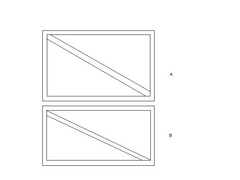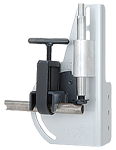in regards to stiffness or won't it make much difference
thanks Tim
[Edited on 5/11/03 by timf]


Rescued attachment bracing.jpg

could you say what of the 2 methods of bracing is better in the attached drawing
in regards to stiffness or won't it make much difference
thanks Tim
[Edited on 5/11/03 by timf]


Rescued attachment bracing.jpg
IMHO - either can be improved by welding parallel sections with the brace. Be it either top/bottom or left/right. Or if more than one brace, then
alternate the parallel's braced ie top/bottom then left/right.
Course I could be totally off the marqué...
My guess would be that it would virtually the same stiffness, but B would fall down in strength. That and the fact the A looks better  . Hellfire -
I'm not sure I follow what you're say.
. Hellfire -
I'm not sure I follow what you're say.
I await Cymtrik's expert reply with interest.
Kingr
A is better.....common centrelines non-offset loading
B is easier...and only minutely inferior
[Edited on 5/11/03 by Alan B]
I've done all mine as in "A" as I too thought it looked better and would ensure that the weld between the upright and the longitudinal
tube was further gussetted by the diagonal tube which should in my simple view be better as it will remove some localised stresses from the weld. (Not
that I'm worried about my welding you understand...)
Cheers,
Craig.
I've used mainly 'B' type joints, but I agree with your points...........my excuse is I'm a lazy git..



Alan,
Thanks.
I actually found the joints quite easy to make. I measured the diagonal angle with a piece of string and a protractor and measured the diagonal
distance with a steel rule. This allowed me to mark the required cut points at both ends which got chopped with a hacksaw. I then chopped the points
off the ends of diagonal piece to clear the existing fillet welds between the longitudinal and vertical tubes before welding in place. Easy peasy!!

When doing the opposite side of the car, then the piece of steel which you cut your first diagonal from will have the correct angle on it for the
other side already ready to be cut to length and trimmed to suit.
Cheers,
Craig.
i was going to have a stab at this question yesterday, though i'd leave it to someone who knows what they're on about, unlike me who just
guesses.
As craig and others point out, the gusset thingy strengthens the weld somewhat, so is probably better. Do people tend to do butt welds or 45 degree
things? I've done most of mine as butts and really its not very clever, should've spent some time getting it nice like others have. Then
type A bracing looks and feels better too as it further strengthens the weld.
Anyway that my tuppence...!
quote:
Originally posted by craig1410
Alan,
Thanks.
I actually found the joints quite easy to make. I measured the diagonal angle with a piece of string and a protractor and measured the diagonal distance with a steel rule. This allowed me to mark the required cut points at both ends which got chopped with a hacksaw. I then chopped the points off the ends of diagonal piece to clear the existing fillet welds between the longitudinal and vertical tubes before welding in place. Easy peasy!!
When doing the opposite side of the car, then the piece of steel which you cut your first diagonal from will have the correct angle on it for the other side already ready to be cut to length and trimmed to suit.
Cheers,
Craig.




cheers for the replys guys
i'm also using the A method but was curious to see if there is any diffences in strength between them.
Tim
Roll on the day when my piggy bank has enough in it to buy a new tube notcher
Shug.
I would say that A would be better in that, there is more weldable area on the ends of the diagonal and the angles are equal.Better still... if you can gusset the corners out - stronger again.
quote:
Originally posted by Hugh Paterson
Roll on the day when my piggy bank has enough in it to buy a new tube notcher
Shug.

hmmm, but what if you want to cut a 46 degree angle ????
(joke)
Mike, I have one.....or at least similar....you can set them for any angle (within reason of course)....
For round they are almost essential.
quote:
Originally posted by Alan B
For round they are almost essential.
Yup, agreed they are not too bad, we have one as well, I was thinking of one of the electric linisher type of notchers. Out of curiosity what type of
cutter are u using, we find that ours eats em. Methinks we have been using cheap guff though 
Shug.
do you mean the device that cuts 'fishmouth' thingys, using some sort of holesaw? I was trying to get one of those cos i saw a build site with some brilliant results from one.
quote:
Originally posted by Hugh Paterson
Yup, agreed they are not too bad, we have one as well, I was thinking of one of the electric linisher type of notchers. Out of curiosity what type of cutter are u using, we find that ours eats em. Methinks we have been using cheap guff though
Shug.



quote:
Originally posted by JoelP
do you mean the device that cuts 'fishmouth' thingys, using some sort of holesaw? I was trying to get one of those cos i saw a build site with some brilliant results from one.
Ok, this thread is getting slighty off-topic. But anyways here are two programs that will make your fishmouth lives easier.
WinMiter
ftp://ftp.ihpva.org/pub/software/winmiter/
EZ Pipe - software for pipe welding patterns
http://www.ezpipe.com/
I haven't used EZ Pipe personally, but winmiter is excellent. It's shareware.
Later,
Graber
Sorry to be a bit late guys.
Alan sums it up very well in his first response. A is theoretically better and looks better. B is only slightly inferior in practice and is probably
easier to assemble.